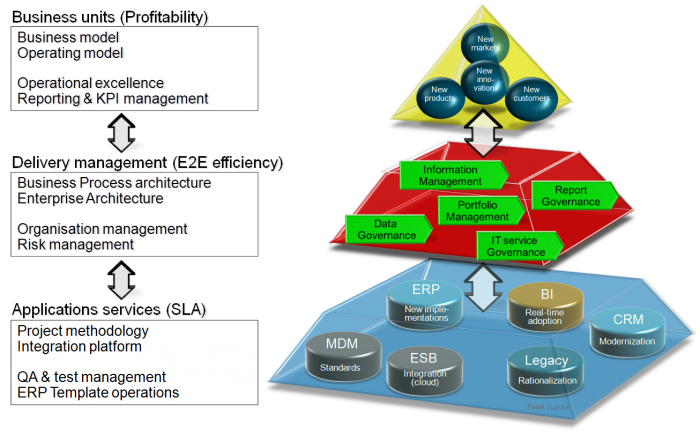The world is changing rapidly, technology (e.g. SMAC (Social, Mobile, Analytics, Cloud) is evolving at a speed never seen before and new innovative ways of doing business are emerging which changes the business models of many organizations.
Many companies are struggling how to quickly integrate the business model changes within their organization and at the same time implement business process improvements, execute ICT projects and maintain the current ICT platforms.
The reason behind this is that departments and/or projects have difficulty sharing and accepting company standards and implement their own (business) concepts, methods and tools.
The solution is to develop an integrated set of best practices which ensures that a change in the business model has an effect on all (business) concepts and is also aligned with the changes in the (ERP) template.
The following picture gives an overview of the multidisciplinary best practices which should be defined, supported by an integrated tool chain and maintained by the ADM governance team;
The ADM governance team should manage the following best practices:
1. Business model
The Business model of the company (e.g. Business Model Canvas by Osterwalder) should be defined and the available PPI’s and KPI’s should be linked to the business model to analyze and optimize the business model innovations on a daily basis.
2 Operating model
The business model should be aligned with the operating model to translate the business model objectives to operating model design principles and strategic directions.
3 Operational excellence
The operational excellence department is responsible for the analysis of the E2E Process Performance Indicators (PPI’s) and the initiation of E2E process improvements and the identification of business innovations
4. Reporting & KPI management
The business model KPI’s (Key Performance Indicators) should be based on the reporting and KPI hierarchy which should be aligned with the Business Process Architecture
5. Business Process Architecture
The Business Process Architecture (BPA) including the ICT programs, should be aligned with the BPO’s (Business Process Owners) objectives within the organization.
6. Enterprise Architecture
The BPA should be extended with FRIME (Forms, Reports Interfaces, Master data, Enhancements) information and align with Enterprise Architecture standards.
7 Organization management
The organization structure should be aligned with the E2E business processes and should define global process roles & local HRM positions
8. Risk management
The E2E processes should be extended with process and access controls and integrated with the GRC (Governance, Risks and Control) dashboard to mitigate business risks and report on auditing requirements like SOx an FDA.
9. Project methodology
The company project methodology deliverables (e.g. business requirements, solution designs) and FRIME functional and technical designs, should be stored within a common documentation library which is structured according to the BPA.
10. Integration platform
The E2E processes & data flows across ICT platforms should be supported by an E2E integration platform (IBO) to facilitate integration of IOT (Internet Of Things) and SMAC.
11. Quality and test governance
Ensure the traceability of E2E test & learning scenarios and the central registration of the E2E process issues for effective quality checks.
12. ERP Template operations
Template management should manage and monitor the execution of global and local E2E processes, share best practices and support efficient (ERP) template changes and template roll-outs.
ADM Governance team
The ADM governance team must control the ADM best practices and the alignment between the data governance managers, the reporting governance managers, the business information (BIM) managers and IT service managers (ITSM) managers.The ADM governance team must also create an integrated ADM project portfolio in which the various project portfolio’s from the business units, ICT support, project and program managers and enterprise architects are integrated. This reduces the OPEX and optimizes the CAPEX of the company.


